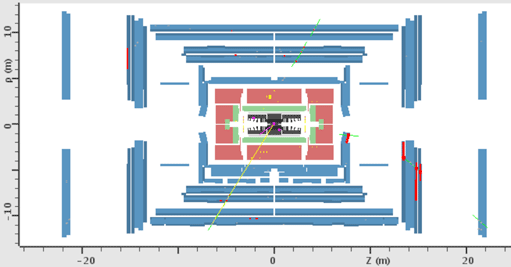
ATLAS e-News
23 February 2011
Background Taskforce
19 October 2010

Event display believed to show a cosmic muon (green, top) overlaid on a genuine proton-proton collision, and faking a jet in the Tile Calorimeter (yellow square). Tools now in preparation will hopefully allow automatic rejection of background events like this.
Sifting genuine collision-related interactions from the general hubbub of particle interactions taking place in the ATLAS detector is an essential part of accurate physics analyses. The Non-collision Backgrounds Taskforce has just concluded five months work investigating the nature of these backgrounds in ATLAS and assessing the best methods of dealing with them.
'Non-collision backgrounds' takes into account: cosmic rays passing through the detector, instrumental effects like noise bursts in certain parts of the detector, and beam backgrounds (related to the vacuum conditions in the beam pipe, the number of protons injected per bunch, and beam cleaning activities).
“It used to be that sub-detectors, physics groups, and performance groups dealt with such backgrounds in their own ways,” says taskforce co-chair, David Berge. “So we tried to create a forum where we discuss all together what the best treatment is and try to develop global strategies to suppress them.”
For the last five months, David and co-chair Witold Kozanecki have been meeting weekly with representatives from each of the sub-systems to try to characterise the main non-collision backgrounds and estimate the rates at which they occur in ATLAS. Their final report outlines procedures to help physics groups deal with these backgrounds, laid out like a recipe.
“It's to streamline the approach a little bit,” explains David. “To make sure everyone does sensible things in the beginning to estimate backgrounds for their particular analysis.”
Backgrounds are analysis dependent, he points out. Electrons, which usually originate from vertices close to the interaction point (IP) of the proton beams, are fairly unmistakable. On the other hand, it is much harder to decipher which single jets originate from collisions, and which from non-collision backgrounds.
One way to estimate beam-related or cosmic backgrounds from data is to look at empty or unpaired bunches in the two incoming beams. In the absence of proton-proton collisions, events can be attributed to cosmics, proton collisions with gas molecules in the imperfect vacuum (beam gas events), or particles cascading into the detector as outlier protons slam into the beam-cleaning collimators upstream of ATLAS (beam halo events).
Another good indicator of beam halo backgrounds is the number of pixel clusters per event. Beam halo particles travel roughly in the direction of the beam, a little removed from it. They leave characteristically long clusters of hits through the length of the Pixel detector, whereas collision debris usually flies outwards, leaving small concentrated clusters of hits as it makes the traverse.
It was thanks to background studies that ATLAS was able to alert the LHC to the vacuum problems around the IP a few weeks ago. When the halo seen by the beam-conditions monitors – whose fine timing resolution allows them to distinguish between beam halo and particles of IP origin – and the Level 1 trigger rate both went up by an order of magnitude, it was obvious something was up. Examining the calorimeter data also revealed 2.5 times more fake jets than usual.
LHC experts identified two sections of unconditioned beam pipe, 60 metres on either side of ATLAS, where the vacuum quality is badly degraded when both beams are present. The culprit was the 'electron cloud' effect, where a few electrons on the loose are accelerated and multiplied when the beam goes by. These electrons bombard the vacuum pipe, kicking out many gas molecules.
“The LHC engineers promptly installed makeshift solenoid widings around this part of the beam pipe...” explains Witold Kozanecki. “This simple technique – combined with a bit of patience to let the vacuum clean itself – solved the problem.”
This is a great example of why being able to monitor beam backgrounds online is a worthwhile goal being worked towards – so that such background issues can be immediately diagnosed in the future and the information fed back quickly to the LHC.
The initial aims of the taskforce have been achieved but the group's work will now continue, becoming integrated into regular data preparation work, says David: “We won't call it a taskforce anymore, but will stay as a group under the data preparation umbrella, to oversee the implementation of the recommendations we came up with and develop strategies to monitor background conditions at Point 1.”
The list of things-to-do includes developing tools to automatically reject backgrounds. Normal reconstruction algorithms are unlikely to find beam halo tracks “because they haven't been looking for such a weird track in the first place”. Algorithms which link tracks in the Inner Detector, energy deposits in the calorimeter, and hits in the muon system already exist – but not for tracks originating far away from the IP, as beam gas events might. And whilst cosmic-spotting algorithms do exist, they aren't run on normal collision data.
“Such a track reconstruction is normally done in full scan mode over the whole detector, which is CPU intensive,” explains David when asked why not. “I would hope that we can do some kind of optimisation, for example not looking at the deposits that are clearly attributed to collisions, but only looking at the ones which are left over. In its default mode, the algorithm doesn't do that right now.”
Simulating and monitoring how the beam backgrounds and the noise from the detector itself respond to increased luminosity and protons-per-bunch is also a high priority.
“The hope is that we develop one common approach for ATLAS to non-collision backgrounds,” says David, “but even when all our recommendations are implemented, there will still need to be some constant investigation of background levels at the final analysis stage.”
 Ceri PerkinsATLAS e-News
|